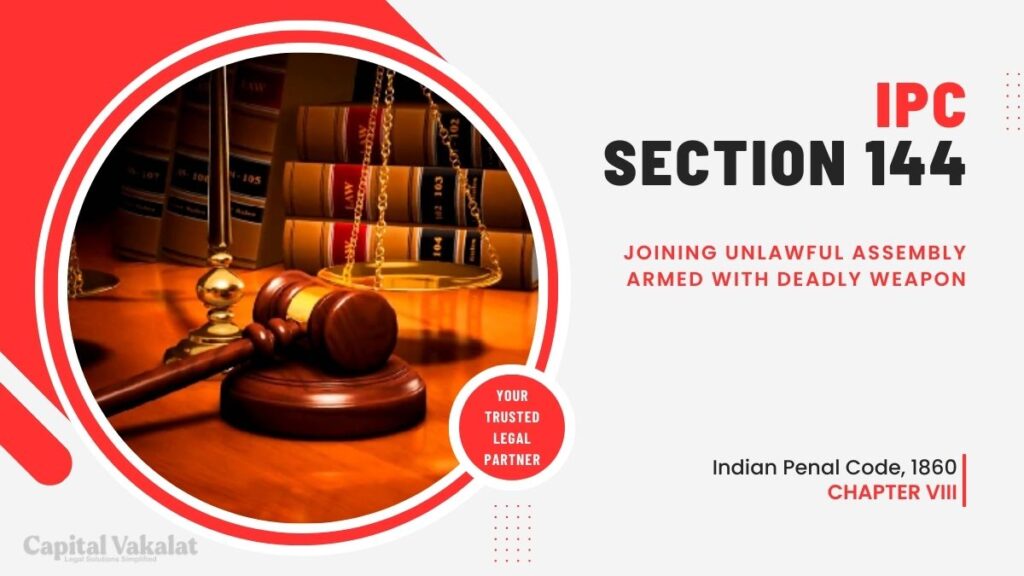In India, maintaining public order is of paramount importance, and the legal system has provisions in place to address situations where public order is under threat. One such provision is Section 144 of the Indian Penal Code (IPC), which empowers local authorities to take necessary actions to maintain public tranquility.

This article delves into the specifics of Section 144 IPC, focusing on the offense of joining an unlawful assembly armed with a deadly weapon.
Understanding Section 144 IPC
Section 144 of the Indian Penal Code is a legal provision that grants district magistrates, sub-divisional magistrates, and other authorities the power to issue orders to prohibit the assembly of people in certain areas, or to impose specific conditions on such assemblies. The primary objective is to prevent any activity that may lead to a disturbance of public peace and tranquility. This legal provision is invoked when there is an imminent threat to public order.
Joining Unlawful Assembly
An essential aspect of Section 144 IPC is the prohibition of unlawful assemblies. An unlawful assembly is defined as an assembly of five or more persons who have a common object, and whose assembly causes a reasonable apprehension of a breach of peace. Joining such an assembly, even without a deadly weapon, is considered a violation of the law. The penalty for participating in an unlawful assembly can be severe, including imprisonment.
Armed with a Deadly Weapon
When individuals join an unlawful assembly while being armed with a deadly weapon, the situation becomes far more critical. A deadly weapon is defined as any instrument or object that is used, or attempted to be used, with the intent to cause death or bodily harm. This includes firearms, knives, and any other instrument capable of inflicting fatal injuries. Being armed with such a weapon during an unlawful assembly escalates the offense significantly.
Legal Ramifications
The legal ramifications of joining an unlawful assembly armed with a deadly weapon are severe. Those found guilty can face imprisonment, fines, or both, depending on the circumstances of the case and the discretion of the judiciary. It is important to note that the legal system takes a strict stance on such offenses due to the potential for violence and harm to public order.
To illustrate the seriousness of this offense, let’s look at a few notable cases where Section 144 IPC was invoked.
Notable Cases
- [Case 1] – In a recent incident, a group of individuals armed with lethal weapons gathered in a public place, leading to a public uproar. The local authorities imposed Section 144 IPC to disperse the assembly and maintain public order. Several individuals were arrested and subsequently convicted under this law.
- [Case 2] – During a protest rally, a participant was found carrying a concealed firearm. This incident was in violation of Section 144 IPC as it posed a severe threat to public safety. The person was charged and found guilty of this offense.
Proving Guilt
In cases related to Section 144 IPC, the burden of proof lies with the prosecution. To secure a conviction, the prosecution must provide sufficient evidence to establish that the accused knowingly participated in an unlawful assembly and was armed with a deadly weapon. This often involves eyewitness testimonies, forensic evidence, and other relevant proofs.
Defenses and Exceptions
Individuals accused under Section 144 IPC may have defenses or exceptions to consider. It is essential to seek legal counsel to explore potential defenses such as lack of knowledge, self-defense, or any other relevant circumstances that could mitigate the charges.
Public Safety and Security
The underlying purpose of Section 144 IPC is to ensure public safety and security. It empowers local authorities to take swift action when there is a genuine threat to public order. However, striking a balance between individual rights and societal interests is crucial.
Application of Section 144 IPC
Section 144 IPC is typically invoked during situations of protests, rallies, or gatherings that have the potential to escalate into violence. Recent events, such as public demonstrations and political rallies, have seen the application of this legal provision to maintain peace and protect public safety.
Legal Procedures
When local authorities invoke Section 144 IPC, there are specific legal procedures to be followed. The orders issued under this section are subject to judicial review, ensuring that they are not arbitrary and are within the scope of the law.
Impact on Civil Liberties
While Section 144 IPC is necessary for maintaining public order, it does raise concerns about its impact on civil liberties. Striking the right balance between public safety and individual rights is an ongoing challenge. Transparency and accountability in the application of this law are essential to protect civil liberties.
Public Awareness and Education
It is vital to educate the public about Section 144 IPC to prevent unintentional violations. Many individuals may not be aware of the legal implications of joining an unlawful assembly or carrying deadly weapons in such situations.
FAQs
Can I be charged under Section 144 IPC for joining a peaceful protest with a lawful weapon, such as a licensed firearm?
Section 144 IPC primarily targets unlawful assemblies. If you’re part of a peaceful and lawful assembly, you are unlikely to be charged, even if you possess a licensed weapon.
What constitutes a “deadly weapon” under Section 144 IPC?
A deadly weapon is an instrument capable of causing death or serious bodily harm. This includes firearms, sharp-edged weapons, and any object used with the intent to cause harm.
What should I do if I believe Section 144 is wrongly imposed in a particular situation?
Seek legal advice and assistance. If you believe that Section 144 is incorrectly imposed, you have the right to challenge it through legal means and judicial review.
How can I contribute to public awareness about Section 144 IPC and its implications?
You can educate your community about Section 144 IPC and its consequences for public order. Share information through social media, community meetings, or workshops to raise awareness and prevent unintentional violations.